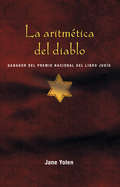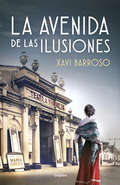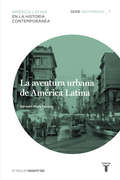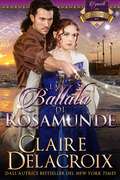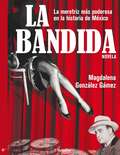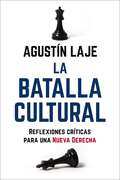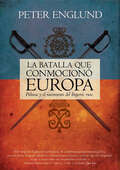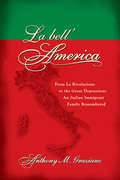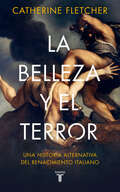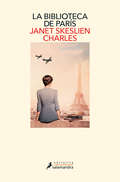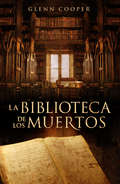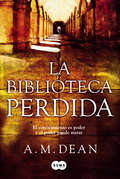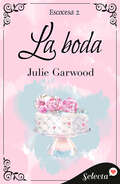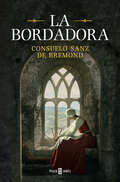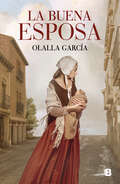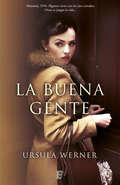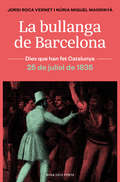- Table View
- List View
La aritmética del diablo
by Jane YolenGanador del Premio Nacional del Libro Judío Hannah está cansada de las fiestas religiosas; su familia solo habla del pasado. De hecho, le parece que eso es lo que hacen en todas las fiestas judías. Pero este año, el Seder de Pesaj será diferente, Hannah será transportada misteriosamente al pasado... y solo ella conoce los horrores indescriptibles que le esperan.
La asistente del boticario
by Sandra SookooCuando el destino llama puedes huir o quedarte a pelear por lo que siempre haz querido. De cualquier manera no tendrás más opción que cambiar. La señora Ava Southerly, asistente del boticario y viuda, vive con miedo. Se ha hecho experta en esconderse para detener sus visiones del futuro. En el año 1885, cosas como las brujas ya no existen, sin importar su linaje. Si mantiene su corazón libre de emociones, sus poderes sobrenaturales permanecerán dormidos y la gente que ama no será lastimada, pero anhela la aceptación y el romance. Douglas Wallace, doctor americano y descendiente de un cazador de brujas escocés, está en Londres para dar una serie de conferencias sobre nuevas técnicas y descubrimientos médicos. Al ver pasar a una hermosa rubia por la ventana de un restaurante, siente la necesidad de seguirla, como si sus vidas estuvieran ligadas en un nivel sobrenatural. Aunque él cree en la lógica y la evidencia de sus propios ojos, el pasar tiempo en la compañía de Ava le muestra lo equivocado que está. Cuando un espíritu malvado de 300 años posee a Douglas en un esfuerzo por matar a Ava por ser bruja, ella y el doctor deben encontrar la manera de impedir esta amenaza del más allá, a pesar del peligro. Mientras su relación evoluciona en algo más profundo y duradero, descubrirán qué tan fuerte es el amor verdadero.
La atrevida decisión de Lady Jane (Minstrel Valley #Volumen 14)
by Marcia CotlanContinúa la rompedora serie de «Minstrel Valley», creada por catorce autoras de Selecta. Ambientada en la Inglaterra de la Regencia en un pequeño pueblo de Hertfordshire, descubrirás una historia llena de amor, aventuras y pasión. Una apasionante encrucijada entre el deber y el amor. Lady Jane Walpole ha tenido una vida dura y llena de humillaciones, así que se jura a sí misma que utilizará su belleza para conseguir un matrimonio ventajoso. Ha puesto su mirada en un futuro duque y parece que está a punto de lograr su más ansiado deseo. Justo entonces, se cruza en su camino Hugh Turner, el hombre más atractivo y, sobre todo, el más orgulloso que ella ha conocido jamás, ¡y eso que está muy lejos de ser un hombre rico y encumbrado! O eso cree ella, al menos. Sin querer, Jane hiere el orgullo del señor Turner y a partir de ese instante, su vida se convierte en un vaivén de huidas y encontronazos con el caballero, que no oculta el desdén que la joven le produce. Sobre la serie:Minstrel Valley es un proyecto novedoso, rompedor y sorprendente. Catorce mujeres que crean una serie de novelas gracias a una minuciosa organización que ha llevado tiempo y esfuerzo, pero que tiene su recompensa materializada en estas quince novelas que vamos a disfrutar a lo largo de esta temporada. Esta labor de comunicación entre ellas, el apoyo mutuo, la coordinación y coherencia no hubiese sido posible sin nuestras queridas autoras, que hacen visible que con cariño, tiempo robado a sus momentos de ocio, de descanso y de familia, confianza, paciencia, esmero y talento, todo sea posible. Desde Selecta os invitamos a adentraros en Minstrel Valley y que disfrutéis, tanto como nosotros, de esta maravillosa serie de regencia. Prólogo de Nieves Hidalgo en Si me lo pide el corazón (Minstrel Valley 1):«Serán novelas divertidas, románticas, dulces, plenas de sentimiento, con personajes que os enamorarán; hasta con leyenda incluida. Historias paridas por la imaginación de unas autoras merecedoras de elogio, no ya solo por su capacidad para ilusionarnos, su disposición a compartir sino, sobre todo, por la manera encomiable de aplicarse al trabajo para ofreceros lo mejor de sí mismas.»
La atrevida pasión de una dama
by Zahara C. Ordóñez¿Qué dama puede resistirse a un bandolero cuando este decide robar un corazón?Y ¿qué forajido, por más intrépido que sea, puede escapar de una dama cuando esta se lo propone? Lady Violet Waverley, a juicio de muchos, es una solterona. No le importa. Es feliz viajando por España. El amor no entra en sus planes hasta que conoce a Pedro Baena, un hombre encantador a quien cree haber conocido antes con otra identidad: la de un intrépido bandolero. Violet hará lo posible por saber la verdad sobre él mientras Pedro trata de mantenerla al margen de su pasado. Sin embargo, no puede evitar quererla cerca en el presente. Con cada encuentro, el descaro de él y el atrevimiento de ella serán irresistibles. Pero el pasado de Pedro amenaza con destruirlo y la sombra del matrimonio cae sobre Violet cuando su hermano le da un ultimátum. ¿Será su amor por él tan fuerte como para impulsarla a un compromiso? ¿Podrá él huir de loque fue? «Señorita, no digo las cosas dos veces y he dicho dos veces que la quiero. Eso no lo he hecho por nadie así que deje de hacerse la importante y venga a besarme, o iré yo y entonces no quedará solo en un beso».
La avenida de las ilusiones
by Xavi BarrosoUna mujer rebelde. Un destino incierto. Y un sueño inalcanzable: conquistar los escenarios de Barcelona. Barcelona 1909. Las hermanas Francisca y María Romero llegan a la ciudad en plena Semana Trágica para servir en casa de los Puig, una adinerada familia de la burguesía catalana. En las calles los trabajadores luchan por unas condiciones más dignas, mientras la clase alta se aferra a sus privilegios. Francisca tiene un carácter indomable y la cabeza llena de pájaros, sueña con ser artista y una vida más libre y emocionante que la que la sociedad le ha destinado. Pronto conocerá a Joan, un joven anarquista que le robará el corazón y le descubrirá el brillo y la magia del Paralelo. Pero un fatídico acontecimiento sacude el alma de las hermanas Romero y empuja a Francisca a perseguir su sueño: convertirse en la reina de los teatros del Paralelo. Francisca buscará su lugar y jugará con sus lealtades en una Barcelona revolucionaria y en plena ebullición teatral. Conocerá el lado más oscuro de la ciudad, vivirá la humillación, la soledad, la traición y un amor imposible que marcará su vida. Pero nunca renunciará a su sueño. En una época en que las mujeres ni siquiera tenían derecho al voto, Francisca siempre será una mujer libre. Reseña:«El amor, la amistad, las aspiraciones frustradas, lo dura que puede resultar a veces la vida... Todo ello a través de la mirada de una joven que solo trata de escapar de la vida que se le ha impuesto para poder ser feliz haciendo lo que realmente le gusta. La avenida de las ilusiones es una novela fascinante y completamente absorbente.»Mewmagazine.es
La aventura (Belgravia #5)
by Julian FellowesBelgravia, del creador de Downton Abbey, Julian Fellowes, es una historia publicada en 11 capítulos en la mejor tradición de las novelas por entregas. Los clubs de apuestas de Londres y una cita secreta proporcionan el escenario para todo tipo de indiscreciones, grandes y pequeñas. Descúbrelo en esta quinta entrega de Belgravia. Muy cerca de Buckingham Palace, tras las puertas de las grandes mansiones del Londres victoriano reinan el escándalo y la intriga. Bienvenidos a Belgravia. Ambientada a mediados del siglo XIX, en una sociedad victoriana en la que los nuevos ricos de la industria y el comercio comienzan a codearse con la más arraigada aristocracia, Belgravia está poblada por un rico reparto de fascinantes personajes. Esta es la historia de un secreto. Un secreto que se oculta al otro lado de las elegantes puertas del barrio más exclusivo de Londres. Su historia será desvelada en capítulos sucesivos llenos de giros, revelaciones y finales inesperados. La crítica ha dicho...«Belgravia es una entretenida y fascinante historia sobre el tema favorito de Fellowes: las clases sociales. Hará las delicias de muchos lectores.»Sunday Times
La aventura de Luca en Florencia (¡Arriba la Lectura!, Level T #42)
by Cameron Macintosh Alessandro BaldanziEl hermano mayor de Luca, Renzo, se ha ido de la granja y se ha mudado a Florencia para trabajar como ayudante de un artista. Mientras Luca aprende carpintería con su padre, se pregunta cómo será vivir en el taller de una artista en la gran ciudad. NIMAC-sourced textbook
La aventura urbana de América Latina. Recorridos_3
by GERMÁN MEJÍA PAVONYEl ochenta por ciento de los latinoamericanos vive hoy en poblaciones de más de 20.000 habitantes. Esta cifra sorprende, pues aceptamos que la mayoría de las localidades de la región apenas sobrepasa el carácter rural. En realidad, la historia del desarrollo urbano del subcontinente ha sido desdeñada por teorías victimistas que la condenan sin remedio al atraso; por ello, resulta paradójico que desde los primeros años del siglo XIX la ciudad se revelara esencial para la construcción de los nuevos Estados nacionales, y que la producción de riquezas, de origen agrario o minero, encontrara en sus urbes la única posibilidad para transformar la sociedad entera. La historia de América Latina es, en este sentido, una aventura de futuro que se construye desde las entrañas de su ya longeva dinámica urbana. Recorridos se propone destacar los ejes comunes a la historia de América Latina en una perspectiva global, libre de visiones nostálgicas y exóticas. La serie analiza desde la independencia hasta la actualidad temas y horizontes que trascienden lo nacional, tanto en el espacio como en el tiempo. Mediante una narrativa accesible y con un enfoque novedoso, identifica elementos de originalidad social y cultural. También reflexiona sobre la potencia y la presencia de América Latina en tiempos de globalización, en los que se ha convertido en destacada protagonista.
La ballata di Rosamunde (I gioielli di Kinfairlie #4)
by Claire DelacroixIntrappolata nel Regno delle Fate, Rosamunde può essere liberata solo dal vero amore...ma l'uomo che lei amava è morto. Padraig vorrebbe che la loro amicizia si trasformasse in qualcosa di più...riuscirà a conquistare il cuore di Rosamunde per sempre?
La bandida
by Magdalena González GámezNovela de aventuras para todo público. La bandida es una gran novela histórica sobre una mujer temeraria y única. Su nombre todavía es leyenda. Esta novela ofrece un retrato vivo e inmejorable de uno de los personajes populares más enigmáticos del México del siglo XX. Marina Aedo o Graciela Olmos, huérfana, guerrillera, prostituta, asaltante, adicta, bandida, compositora, cantante; piadosa, caritativa, incondicional; fue la meretriz más influyente y poderosa del México posrevolucionario y es la protagonista de esta historia que cuenta la existencia y las vicisitudes no sólo de una vida, sino del funcionamiento de un México que ya no nos tocó conocer. Ésta es una recreación surgida de la multitud de versiones contradictorias y misterios, rencores y afectos, que rodean hasta hoy la vida de Graciela Olmos, poseedora de una personalidad con tendencia tanto al delirio psicótico como a la reflexión filosófica certera que la convirtió en uno de los personajes más enigmáticos de nuestra historia. Sexo, intriga política, violencia, folclore lírico y psicología de género son sólo algunos de los componentes de esta novela, la cual transcurre por varios sitios y épocas de la geografía nacional, desde la Revolución hasta fines de la década de los cincuenta, e incluso llega al Chicago de la Gran Depresión, donde el brutal e inesperado encuentro entre la Bandida y Al Capone nos ofrecerá algunas sorpresas.
La batalla cultural: Reflexiones críticas para una Nueva Derecha
by Agustin LajeEl afamado escritor, politólogo, y conferencista Agustín Laje presenta La batalla cultural: Reflexiones críticas para una Nueva Derecha – un manifiesto que informará, animará y facultará a los &“guerrilleros culturales&” para no bajar los brazos en la batalla que sigue perjudicando a nuestras familias y a la sociedad en general.En el mundo contemporáneo, la sociedad y la cultura cambian a gran velocidad. La voluntad de dirigir esos cambios está en la base de las batallas culturales que hoy se viven en todas partes. Bien investigado y argumentado inteligentemente, este libro define el concepto de batalla cultural y muestra hasta qué punto la cultura ha llegado a ser el botín principal del poder, cómo se han desarrollado estas batallas desde los tiempos modernos hasta la actual posmodernidad y cómo enfrentarlas.En este libro, Agustín Laje:Explica qué es la batalla cultural, cómo darla, y cuales son su característicasAnaliza cómo la nueva izquierda entendió este fenómeno, frente a una derecha que menospreció el poder de la culturaExamina cómo entendió este fenómeno la nueva izquierda, frente a una derecha que menospreció el poder de la culturaPretende brindar las herramientas necesarias para el nacimiento de una nueva derechaEste libro está dirigido a: Las familias que son el principal blanco de ataque en este momento, que se sienten fragmentadas, amedrentadas y que quieren hacer algo más para convertirse en agentes de batalla culturalA los Jóvenes que cursan sus estudios y que entienden que en sus universidades cada vez hay menos educación y más adoctrinamientoA todo aquel que se preocupa por los asuntos políticos y mundiales de gran magnitud que crean conflictos en la sociedad&“La lucha política y la lucha cultural son las dos caras de una misma moneda. Si no hay política sin hegemonía, entonces tampoco hay política sin batalla cultural&”, dice Laje. &“La batalla cultural terminará mostrándose como la madre de todas las batallas.&”The Culture BattleFamed writer, political scientist, and lecturer Agustín Laje presents The Culture Battle: Critical Reflections for a New Right – a manifesto that will inform, encourage and empower the &“cultural guerrillas&” not to give up in the battle that continues to harm our families and society in general.In the contemporary world, society and culture are changing at great speed. The will to lead these changes is at the basis of the cultural battles that are being fought everywhere today. Well researched and intelligently argued, this book defines the concept of cultural battle and shows to what extent culture has become the main spoils of power, how these battles have developed from modern times to today's postmodernity and how to face them.In this book, Agustín Laje:Explains what the culture battle is, how to wage it, and what its characteristics areAnalyzes how the new left understood this phenomenon, in the face of a right wing that underestimated the power of cultureExamines how the new left understood this phenomenon, in the face of a right wing that underestimated the power of cultureAims to provide the necessary tools for the birth of a new right wing
La batalla que conmocionó Europa: Poltava y el nacimiento del Imperio Ruso
by Peter EnglundPoltava y el nacimiento del Imperio Ruso. La batalla de Poltava en 1709 marca el nacimiento del Imperio ruso de Pedro el Grande. En 1700, el zar, de acuerdo con Dinamarca, Sajonia y Polonia, decidió acabar con la hegemonía sueca del norte de Europa. Cuando estas fuerzas internacionales consiguieron derrotar a las tropas del rey Carlos XII en Poltava, Ucrania, empezó el principio del declive y colapso del Imperio sueco y el ascenso de Rusia.Junio de 1709. La guerra dura ya nueve largos años, y el ejército de Carlos XII sitia la ciudad de Poltava, en Ucrania. La caravana a Moscú se ha detenido, y el ejército ruso bajo las órdenes del zar Pedro está solo a cuatro kilómetros de distancia. Los suecos se han estado preparando para la batalla y las tropas, que habían estado desperdigadas por las llanuras de Ucrania, se han congregado. El plan consiste en marchar al amparo de la oscuridad y pillar a los rusos por sorpresa, pero cuando sale el sol todo el plan se desbarata.En este libro se retrata el golpe fatal, hora tras hora, la catástrofe que sesgó 10000 vidas. Se analizan las estrategias en el campo de batalla, los detalles que hacen la historia comprensible, real. A través de los diarios y cartas de los testigos, lo sucedido se llena de las voces de los que estaban allí: el general, sus sirvientes, soldados, el capellán y la viuda de un soldado...
La bell'America
by Anthony M. Graziano"This is a delightful, passionate and memorable rendition of a familiar and glorious tale. As the son of immigrants who were very much like Anthony Graziano's family, I was especially moved. Thank you for telling our story."-Governor Mario M. Cuomo"This kind of historical data is rare today. . . . A tapestry of history, biography, personal reminiscence, and lessons."-Michael Giallombardo, director/producer of La Terra Promessa"A sweeping narrative of European and American history, and a lovingly crafted reminiscence. Graziano is an excellent storyteller. There is something in this book for everyone, not least of which is a very good read."-Joan M. Crouse, author of The Homeless Transient in the Great Depression"Writing in the tradition of C. Wright Mills, who defined [sociology] as the intersection between history and biography . . . this book clarifies the tremendous emigration from Italy. A very enjoyable read, suitable for general readers and students of history and sociology."-Adeline Levine, author of Love Canal: Science, Politics, and PeopleA picture of Europe's nineteenth century and the massive Italian immigration to America: wars and conflicts, popes and kings fighting the people's demands for democratic government. When religion and royalty failed them, leaders created dictatorships and threw the world into bloody conflicts, killing hundreds of millions and virtually destroying Europe. Caught up were the poverty stricken, powerless common people who became the immigrants, pushed from Europe, pulled to America. Their history comes alive in the author's deeply personal account of his family's immigration and survival through the Great Depression.Anthony M. Graziano, SUNY Buffalo professor emeritus and Italian chef, has written fifteen books and fifty articles in the field of psychology. His brother, parents, and extended family emigrated from Italy. He says, "This book is a celebration of immigrants. It speaks to us because we are all immigrants."
La belleza y el terror: Una historia alternativa del Renacimiento italiano
by Catherine FletcherUn retrato poderoso, moderno, íntimo y profundamente humano de una era de destrucción extrema y creatividad excepcional, el renacimiento italiano, un periodo que moldeó la cultura occidental y que fue mucho más extraño, oscuro y fascinante de lo que nos han enseñado. Conocemos a la Mona Lisa por su sonrisa enigmática, pero casi nadie sabe que estuvo casada con un traficante de esclavos. Veneramos a Leonardo da Vinci por su arte, pero pocos hoy somos conscientes de la importancia de sus ingeniosos diseños de armamento. Rara vez oímos hablar, asimismo, de las mujeres escritoras, los mercaderes judíos, los ingenieros, las prostitutas y los granjeros que vivieron el día a día de este periodo. Muchos de los artistas y pensadores más célebres del Renacimiento (como Miguel Ángel, Rafael o Maquiavelo) no surgieron durante el famoso renacer del siglo XV, sino en el XVI, una época dominada por una serie de luchas de poder y guerras salvajes por toda Europa. Estas propiciaron el surgimiento de grandes fortunas y la creación de algunas de las mejores obras de arte jamás vistas, pero también devastaron al pueblo. Al mismo tiempo, el nacimiento del protestantismo, la colonización española de América y la expansión del Imperio otomano plantearon graves amenazas al poder italiano, y suscitaron debates sobre la ética política, la esclavitud, las creencias religiosas y la moral sexual que resuenan con muchos debates actuales. En este extraordinario libro, historia narrativa y de alta calidad y rebosante de vida, Catherine Fletcher nos descubre el lado oscuro del Renacimiento, cuyas conexiones con el presente son mucho más interesantes que las que ofrece la simple visión, dominada por bellas imágenes, que nos ha contado la historia convencional. La crítica ha dicho...«Brillante y apasionante. He aquí el verdadero Renacimiento en una historia de una originalidad y una frescura cautivadoras.»Simon Sebag Montefiore «Una historia de alianzas, traiciones, saqueos, asedios, hambrunas, asesinatos y torturas terriblemente ingeniosas. Fletcher crea atmósfera y drama sin renunciar a la claridad. Poderoso.»The Guardian «Aterrador y fascinante, desmantela los tópicos sobre el Renacimiento con la precisión de un arcabuz. Ambicioso y plural, arroja luz sobre figuras a menudo olvidadas por la historia convencional.»The Sunday Times «Impresionante y lúcido, el relato brilla con sus coloridos detalles. Una historia sólida pero vívida y convincente sobre cómo Italia fue derribada aún cuando su cultura volaba alto.»The Times «Basado en una investigación impecable y admirablemente bien escrito, aporta datos de gran interés en cada página.»The Sunday Telegraph «La sabiduría de Fletcher es envidiable. Sabe mejor que nadie lo traicioneros que fueron ese momento y ese lugar.»The Daily Telegraph «Magnífico. Fletcher muestra cómo excavar bajo los tesoros artísticos y comerciales del Renacimiento en Italia puede revelar fuertes conexiones entre cultura, negocios, religión y violencia.»Financial Times
La bestia delle Highlands
by Adele Contenti April HolthausPer centinaia di anni, la Scozia ha lottato contro gli Inglesi per conservare l'indipendenza. Adesso è costretta ad affrontare un nuovo nemico. In un mondo diviso tra politica e religione, il giovane re James V è minacciato dalla sua stessa gente. Quando tra i clan delle Highlands scoppia la guerra civile, James recluta un gruppo segreto di guerrieri affinchè lo proteggano dai ribelli. Li chiama Protettori della Corona. Ian MacKay ha una missione: catturare uno degli uomini più pericolosi delle Highlands. Ma quando nella sua vita irrompe la figlia di un nemico, è il suo cuore a cadere in trappola. La vita di Keira Sinclair è sempre stata semplice e pacifica. Ma il suo clan è sul punto di andare in rovina, e per impedirlo il padre la costringe a sposare il laird di un clan vicino. Durante il viaggio che la porterà nella sua nuova casa, la carrozza viene attaccata, e Keira è presa in ostaggio da un uomo spietato. Coinvolta in una guerra che lei non capisce, riuscirà a custodire i propri segreti, oppure soccomberà al guerriero delle Highlands che adesso minaccia il suo cuore?
La biblioteca de París
by Janet Skeslien CharlesUna historia de valentía y traición basada en las vicisitudes de los trabajadores de la Biblioteca Americana de París en la Segunda Guerra Mundial. París, 1939. La joven Odile Souchet lo tiene todo: un atractivo novio oficial de policía y un trabajo de ensueño en la Biblioteca Americana de París. Pero cuando estalla la guerra y los nazis marchan sobre París, Odile se expone a perder todo lo que le importa, incluida su querida biblioteca. Sabe que en los momentos difíciles los templos de la cultura peligran porque los libros contienen palabras e ideas prohibidas que deben destruirse. Odile no puede permitir que eso suceda: debe salvar esas páginas, de modo que puedan nutrir la mente de quien llegue después. Junto con sus compañeros, se une a la Resistencia y pone el centro a disposición de los judíos: expulsados de sus casas, tras los libros se sienten seguros, y Odile los defenderá cueste lo que cueste. La crítica ha dicho:«La biblioteca de París es una novela fresca y emocionante que celebra el papel de las bibliotecas como núcleos de comunidad, especialmente cuando las más necesitamos. Nos muestra que la literatura puede ser una vía de escape, un catalizador para la conexión humana y una brújula moral en tiempos oscuros. Una lectura sumamente agradable, con mucho corazón,y rebosante de referencias que harán las delicias de los aficionados a los libros».Matthew Sullivan, autor de Midnight at the Bright Ideas Bookstore «Una carta de amor a París, al poder de los libros y a la belleza de las amistades intergeneracionales».Booklist «Un libro encantandor, rico en detalles... los lectores de literatura histórica se verán atrapados por el realismo de la narración y la amistad que se forja entre una viuda y una joven solitaria».Publisher's Weekly
La biblioteca de los muertos (La biblioteca de los muertos #Volumen 1)
by Glenn CooperTu destino está escrito. Y el de toda la humanidad... ¿Qué harías si supieras la fecha de tu muerte? Bretaña, siglo VII. En la abadía de Vectis crece Octavus, un niño al que le auguran poderes diabólicos. Octavus no tarda en empezar a escribir una lista de nombres y fechas sin ningún sentido aparente. Pero poco después, cuando una muerte en la abadía coincide con un nombre y una fecha de la lista, el miedo se apodera de los monjes. Nueva York, en la actualidad. Un asesino en serie tiene atemorizada a toda la ciudad. Poco antes de morir, las víctimas reciben una postal con la fecha de su muerte escrita. ¿Quién recibirá la próxima postal? ¿Quién será la siguiente víctima? ¿Quién está detrás de estas muertes? Un secreto escalofriante, oculto desde hace siglos, está a punto de ser revelado. Un thriller soberbio dotado de una intriga estremecedora que ya ha conquistado a más de un millón de lectores en todo el mundo. Reseñas:«Un libro increíble.»Katherine Neville, autora de El ocho «Un thriller inteligente, una novela inolvidable.»Book Reporter «La biblioteca de los muertos no pierde ritmo ni tan siquiera cuando se aventura en busca de los secretos de un convento que recuerda al de Umberto Eco.»Corriere della Sera
La biblioteca perdida
by A. M. DeanEL CONOCIMIENTO ES PODER Y EL PODER PUEDE MATAR.ÉL ERA EL CUSTODIO. Arno Holmstrand está a punto de morir a manos de una organización resuelta a apoderarse del secreto que ha guardado durante toda su vida: la ubicación de la biblioteca perdida de Alejandría y los vastos conocimientos ocultos en ella desde hace siglos. ELLA VA A HEREDAR ESE LEGADO La vida de Emily Weiss va a cambiar más allá de todo lo imaginable. En un minuto pasa de ser profesora universitaria de Historia a viajar a los más lejanos rincones del mundo y descifrar las extrañas pistas dejadas por su mentor, Arno Holmstrand. La están poniendo a prueba, pero ¿con qué fin? ELLOS ESTÁN DISPUESTOS A MATAR POR CONSEGUIRLO Ellos forman el Consejo y ansían el poder y la posición. Su corrupción se extiende desde los más altos niveles de gobierno a los asesinos empelados para lacomisión de sus crímenes. Matarían por el conocimiento arcano de la biblioteca. Y Emily Wess tiene exactamente lo que ellos buscan. Reseñas:«Thriller de lectura rápida, desenfrenada y divertida».Kate Atherton, en Goodreads.com «Un ritmo trepidante con capítulos cortos, giros argumentales, un acertado final, enigmas y pistas para descifrar, misterios históricos, sociedades secretas, conspiraciones en las altas esferas políticas y asesinatos».Blog Me gustan los libros «Una representación completamente nueva de la biblioteca de Alejandría. Un thriller imprescindible que es imposible dejar de leer y con un final fabuloso».Bookoffers.com, Australia «Su lectura suscitó en mí un entusiasmo muy similar al experimentado la primera vez que descubrí las aventuras de Enid Blyton. Los libros deberían ser emocionantes, algunos por lo menos. Me sentí también transportado a los escenarios exóticos y románticos que visitaban los personajes de Agatha Christie en sus novelas desde los años 30. La novela de intriga de A.M. Dean me enganchó desde la primera página. El ritmo es tan rápido que me sentí como si estuviera aferrándome a algo para salvar la vida».5 estrellas, David Spanswick, Amazon Vine «Una aventura amena y muy agradable que incluye una mezcla trepidante de secretos, política en Washington (¡me encanta esa parte!), historia y hallazgos. El autor aporta a la obra la enorme riqueza de sus conocimientos históricos y en ella hay hechos y fechas suficientes para satisfacer al lector más exigente. Apenas tienes tiempo para recobrar el aliento. La protagonista es un gran personaje femenino».Milo's Rambles Book Review «Es una novela cuidada, convincente y satisfactoria, un texto pasapáginas que te absorbe como si de arenas movedizas se tratara.» Sam Christer, autor de El enigma de Stonehenge «Esta novela supone un giro novedoso y fascinante sobre uno de los grandes misterios del mundo: la biblioteca perdida de Alejandría. En ella se engranan a la perfección los hechos históricos con la nueva tecnología y tiene lugar una persecución vertiginosa desde Estados Unidos a Inglaterra, para luego seguir en Egipto y Turquía. Emily Wess parece tenerlo todo en contra cuando se enfrenta a un grupo implacable y despiadado, capaz de anticipar y contrarrestar todos sus movimientos mientras, a la desesperada, intenta desvelar todas las pistas que la conducen hasta la última y sorprendente verdad acerca de la biblioteca perdida. La culminación de la historia resulta tan inesperada como satisfactoria. Nos hallamos ante una lograda opera prima de lectura adictiva».James Becker, autor de La piedra de Moisés
La boda (Escocesa #Volumen 2)
by Julie GarwoodEn las altas tierras de Escocia, una gran batalla y un gran amor están a punto de comenzar... Mientras viaja de Inglaterra a Escocia para casarse con un terrateniente, lady Brenna es atacada por unos fieros guerreros que la capturan y la obligan a casarse con su jefe, Connor MacAllister. Esta boda es el primer paso en una terrible venganza que envolverá a Brenna en las sanguinarias guerras entre los clanes escoceses. Su marido no la ama y le ha prometido que podrá volver a su casa en cuanto le dé un hijo. Pero Brenna no puede negar que diez años atrás, cuando vio por primera vez a MacAllister, pensó que era el hombre de su vida. Y ahora, mientras intenta ganarse el afecto de MacAllister, lady Brenna solo puede confiar en su corazón...
La bonne affaire
by Jill BarnettDe l'auteure à succès du New York Times, Jill Barnett, nous raconte une histoire d'amour drôle et réconfortante entre les sexes. Quand Addie Pinkney hérite de la ferme de sa tante, l'héritage ressemble à une réponse à ses prières ... jusqu'à ce qu'elle arrive et rencontre Montana Creed. Creed a également une revendication sur la terre où sa tante et son oncle ont établi une ferme. Les avocats des deux expliquent qu'ils doivent attendre qu'un juge statue, mais pour assurer sa réclamation plus tôt, Addie se faufile et s'installe dans la ferme avant le Montana, pensant qu'elle l'a vaincu. Mais pas de chance. Montana Creed installe son camp devant la ferme, et ce qui s'ensuit est une charmante guerre d'esprit alors qu'ils tentent tous les deux de chasser l'autre de la terre. Mais bientôt, il y a plus en jeu que la terre qu'ils veulent tous les deux. Ces deux solitaires doivent trouver un moyen de faire une bonne affaire, qui ira bien au-delà d'une parcelle de terres agricoles verdoyantes et de tout ce qui leur est cher.
La bordadora
by Consuelo Sanz de BremondUna novela histórica diferente. Una trama absorbente de romance, emoción y poder que nos sumerge en la fascinante vida cotidiana de una corte medieval. Ningún lector podrá resistirse a las intrigas y secretos de la corte de Vetonia. 1475. En Vetonia, una ciudad de la Castilla de los Reyes Católicos, vive Caterina, una joven condesa que ha enviudado recientemente. Reside en el palacio de su tío, el marqués de Narros, y pretende crear un importante gremio de sastres y bordadores. Para ello, envía a Guillén, su amante, a Valencia con el propósito de encontrar a los mejores artesanos. A su regreso, Guillén traerá a Juana, una prometedora bordadora, que llenará de amor, suspense, drama y secretos los muros del palacio y trastocará la tranquila vida de Caterina.Escrita y documentada con un cuidado exquisito, La bordadora es una novela histórica como ninguna otra. En su ópera prima, Consuelo Sanz de Bremond vuelca todo su conocimiento como investigadora de la historia de la indumentaria, costumbres y vida cotidiana para tejer una trama apasionante de romance, intriga y poder en el atractivo mundo de la corte medieval, que se nos muestra aquí con una viveza y autenticidad inigualables.Consuelo Sanz de Bremond Lloret (Valencia, 1963). Licenciada en Ciencias biológicas por la Universidad Complutense de Madrid, desde hace más de veinte años se dedica a la investigación de la indumentaria, vida cotidiana e higiene en la Edad Media y Moderna, estudios que comparte en su blog opusincertumhispanicus.blogspot.com. Ha publicado diversos artículos científicos de su especialidad y participado como ponente en congresos e impartido conferencias. La bordadora es su primera novela.
La brecha electoral
by Pablo SimónPablo Simón recoge las claves necesarias para enfrentarse a votar con conocimiento de causa. ¿Qué necesitas saber ante unas inminentes elecciones? Cuando vas a darle tu voto a un partido, ¿lo haces mirando hacia los proyectos fracasados o de cara a las promesas del futuro? Todo depende del contexto. Es necesario mantenerse informado, teniendo en cuenta los errores cometidos y pensar en si existe la posibilidad de que se repitan o no. ¿Cómo afectan las brechas sociales, económicas y políticas en los resultados de las elecciones de una sociedad fragmentada?
La buena esposa
by Olalla GarcíaUna apasionante novela ambientada en el siglo XVII sobre cómo Francisca de Pedraza, la primera mujer divorciada de España, pudo romper el vínculo sagrado del matrimonio y liberarse de la crueldad de su marido. EN UN TIEMPO EN QUE EL MATRIMONIO IBA MÁS ALLÁ DE LO SAGRADO Alcalá de Henares, Siglo XVII. Francisca de Pedraza vivió en una época en que los malos tratos y la crueldad formaban parte del sacramento del matrimonio y en que las principales virtudes femeninas eran el recato, la obediencia y el silencio. Ella decidió alzar la voz. EL VÍNCULO CON LA CRUELDAD ERA IRROMPIBLE. Tras pasar su infancia en un convento para niñas huérfanas, la noticia de que un hombre había pedido su mano y podría convertirse en una esposa y madre joven fue toda una alegría. Sin embargo, poco después de la boda, el marido de Francisca se reveló como un monstruo violento con el que llegó a tener dos hijos a pesar de llevarla al borde de la muerte en varias ocasiones. ESTA ES LA HISTORIA DE LA PRIMERA MUJER QUE PUDO SER LIBRE Solo su inteligencia y el apoyo de otras mujeres podrán salvarla a ella y a sus hijos de un destino de crueldad. La reputada novelista histórica Olalla García nos relata la vida y la batalla de una mujer que logró traspasar las fronteras y las convenciones de su época para conseguir la libertad. Hoy, su dolorosa y emocionante epopeya se considera el primer referente de la lucha contra la violencia de género en nuestro país.
La buena gente
by Ursula WernerUna novela sobre la Segunda Guerra Mundial inspirada en un caso real: el bisabuelo de Ursula Werner fue secretario de Estado de Economía durante el régimen de Hitler. En su familia no se hablaba de él, hasta que en 2011 la autora encontró una cantidad de cartas y recortes de periódicos ocultos en la casa de su tía, en Hamburgo. Alemania, 1944. Los niños viven su infancia pese a todo, y los adultos intentan mantener los ojos y los oídos cerrados. Mientras tanto, algunos se juegan la vida por ayudar a otros... Cuando estalla la Segunda Guerra Mundial, Edith y Oskar Eberhardt trasladan a su familia -su hija Marina, su yerno Franz y las hijas de estos- desde Berlín hasta una pequeña casa en la tranquila ciudad de Blumental, cerca de Suiza. Oskar, un miembro del gabinete de Hitler, está ausente casi todo el tiempo, y Franz combate en la guerra, de modo que las mujeres de la casa se quedan solas, llevando una existencia tranquila en una pintoresca población. Sin embargo, la vida en Blumental no es tan idílica como parece. Un joven capitán nazi aterroriza a los ciudadanos a quienes debería proteger. Los vecinos se espían mutuamente, y algunos desaparecen de manera misteriosa. Mientras tanto, Marina colabora con un sacerdote protestante que ayuda a refugiados judíos a cruzar la cercana frontera con Suiza. Todo se complicará cuando Oskar regrese a casa con la noticia de que el Führer viajará a la zona y que piensa visitar a los Eberhardt. Reseñas:«La primera novela de Werner sipone una intensa descripción de las luchas interiores libradas por personas normales, impulsadas a hacer cosas extraordinarias en nombre de la familia, de Dios y del país.»Booklist «El coraje, la lealtad, el amor y el suspense atraparán a los lectores.»RT Book Reviews «La autora presenta los dilemas morales de la familia, tanto en su conjunto como individualmente, de manera maravillosa.»Historical Novel Society
La bullanga de Barcelona: La ciutat en flames. 25 de juliol de 1835
by Jordi Roca Núria MiquelBarcelona: la ciutat en flames El 25 de juliol de 1835 va tenir lloc a Barcelona una revolta popular en què es van cremar diversos convents. Va començar a la plaça de braus d'El Torín de la Barceloneta, des d'on es va estendre ràpidament per tota la ciutat. Els dies següents, els aldarulls van culminar amb l'assalt i destrucció de la primera fàbrica que funcionava amb l'energia del vapor i l'assassinat del governador militar. Abans ja s'havien produït revoltes, però aquesta bullanga -en un context de guerra contra el carlisme i de profunda transformació econòmica- convertirà Barcelona en la ciutat capdavantera del procés revolucionari liberal a la monarquia espanyola en els següents vuit anys. Altres ciutats encendran la teia de la revolució, però cap altra com Barcelona serà capaç de fer caure governs i fer trontollar la monarquia.
